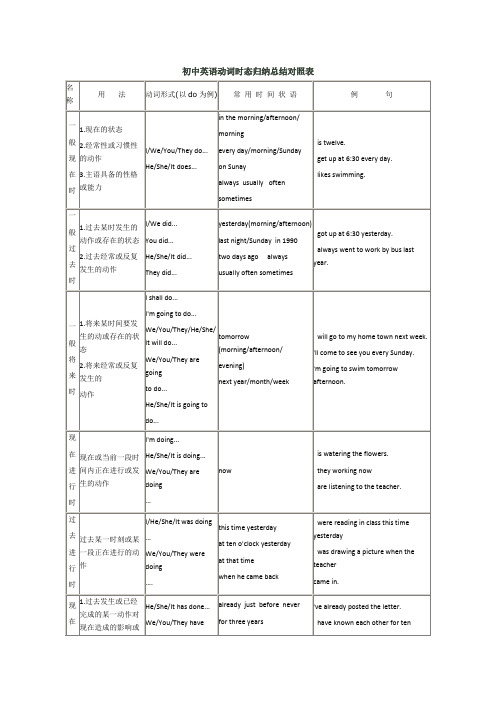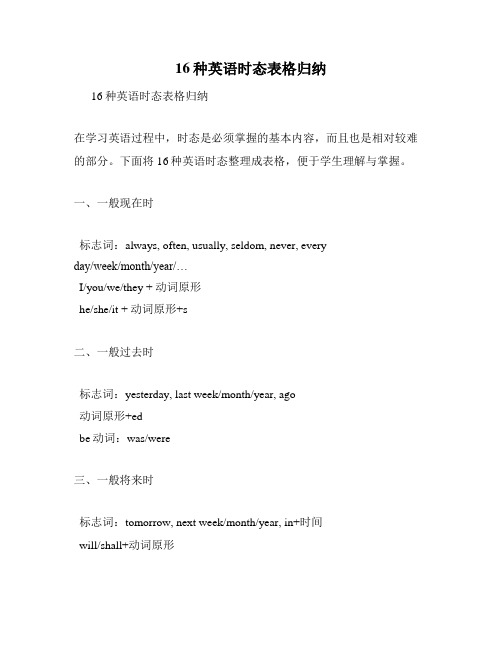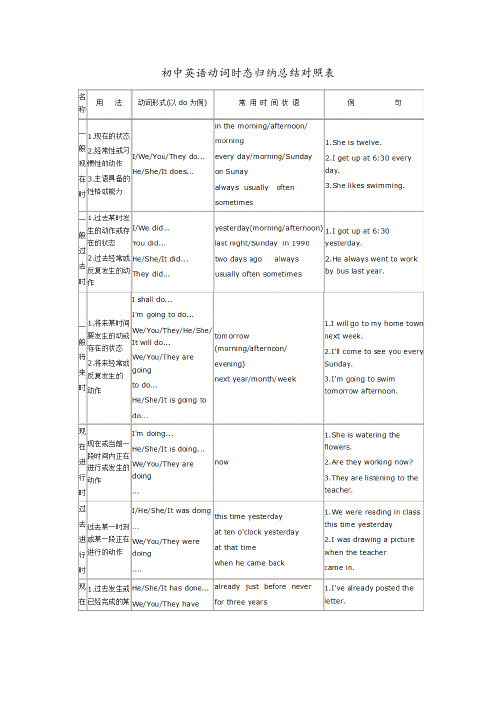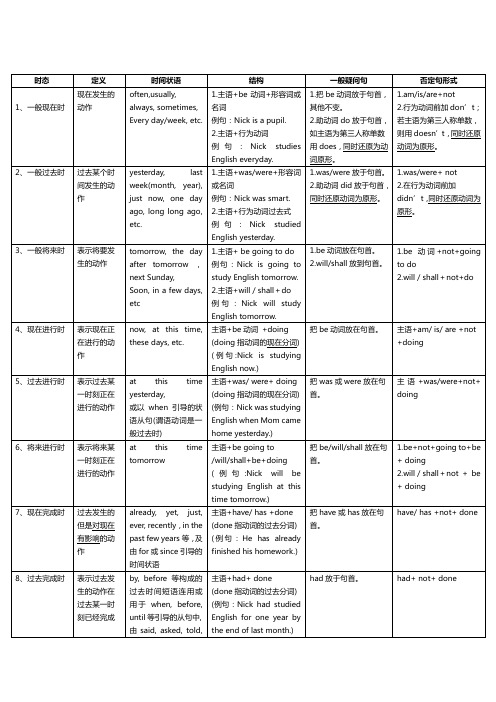(完整版)英语动词时态归纳总结对照表
英语16种时态表格总结

英语16种时态表格总结时态是英语语法中非常重要的一部分,它们用于表示动作发生的时间、顺序和持续性等信息。
了解和掌握英语的各种时态对于学习语言的人来说至关重要。
本文将总结英语中常用的16种时态,并提供表格形式的概览,方便读者更好地理解和运用。
一、一般现在时(Simple Present)表示经常性、习惯性、客观真理形式,以及现在的动作、状态等。
肯定句:主语+动词原形否定句:主语+do/does not+动词原形疑问句:Do/Does+主语+动词原形?二、一般过去时(Simple Past)表示过去某个时间发生的动作或状态。
肯定句:主语+动词过去式否定句:主语+did not+动词原形疑问句:Did+主语+动词原形?三、一般将来时(Simple Future)表示将要发生的动作或状态。
肯定句:主语+will+动词原形否定句:主语+will not+动词原形疑问句:Will+主语+动词原形?四、现在进行时(Present Continuous)表示现在正在进行的动作或状态。
肯定句:主语+am/is/are+动词现在分进行否定句:主语+am/is/are not+动词现在分进行疑问句:Am/Is/Are+主语+动词现在分进行?五、过去进行时(Past Continuous)表示过去某个时间正在进行的动作或状态。
肯定句:主语+was/were+动词现在分进行否定句:主语+was/were not+动词现在分进行疑问句:Was/Were+主语+动词现在分进行?六、将来进行时(Future Continuous)表示将来某个时间正在进行的动作或状态。
肯定句:主语+will be+动词现在分进行否定句:主语+will not be+动词现在分进行疑问句:Will+主语+be+动词现在分进行?七、现在完成时(Present Perfect)表示过去发生的动作对现在造成的影响或结果。
肯定句:主语+have/has+动词过去分词否定句:主语+have/has not+动词过去分词疑问句:Have/Has+主语+动词过去分词?八、过去完成时(Past Perfect)表示过去某个时间之前发生的动作。
初中英语动词时态归纳总结对照表

初中英语动词时态归纳总结对照表初中英语时态专项练习1、一般现在时。
通常用“usually, often, every day, sometimes”。
一般现在时基本用法介绍一、一般现在时的功能1.表示事物或人物的特征、状态。
如:The sky is blue.天空是蓝色的。
2.表示经常性或习惯性的动作。
如:I get up at six every day.我每天六点起床。
3.表示客观现实。
如:The earth goes around the sun.地球绕着太阳转。
二、一般现在时的构成:肯定句:1).主语+系动词be(is, am, are )+名词(形容词,介词短语)2) .其他主语+动词原形+其它第三人称单数+动词-s+其它如:I am a boy.我是一个男孩。
We study English.我们学习英语。
Mary likes Chinese.玛丽喜欢汉语。
三、一般现在时的变化否定句: 1)主语+ be (is,am,are)+ not +其它。
如:He is not a worker.他不是工人。
2)其他主语+do not(don’t)动词原形+其它 I don't like bread第三人称单数+does not(doesn’t)动词原形+其它He doesn't often play.一般疑问句:1)Be(Is,Are)+主语+其它如:-Are you a student -Yes. I am. / No, I'm not.2)Do其他主语+动词原形+其它Does+第三人称单数+动词原形+其它+注意:遇I/we—you, my—your, some—any.Does she go to work by bike - Yes, she does. / No, she doesn't.Do you often play football- Yes, I do. / No, I don't.特殊疑问句:疑问词+一般疑问句。
16种英语时态表格归纳

16种英语时态表格归纳16种英语时态表格归纳在学习英语过程中,时态是必须掌握的基本内容,而且也是相对较难的部分。
下面将16种英语时态整理成表格,便于学生理解与掌握。
一、一般现在时标志词:always, often, usually, seldom, never, everyday/week/month/year/…I/you/we/they + 动词原形he/she/it + 动词原形+s二、一般过去时标志词:yesterday, last week/month/year, ago动词原形+edbe动词:was/were三、一般将来时标志词:tomorrow, next week/month/year, in+时间will/shall+动词原形四、现在进行时标志词:now, at the moment, right now, currently am/is/are+现在分词五、过去进行时标志词:at+时间,when, whilewas/were+现在分词六、将来进行时标志词:at+时间will/shall+be+现在分词七、现在完成时标志词:ever, never, already, yet, justhave/has+过去分词八、过去完成时标志词:before, by the timehad+过去分词九、将来完成时标志词:by+时间will/shall+have+过去分词十、一般过去时被动语态标志词:被动语态was/were+过去分词十一、现在完成时被动语态标志词:被动语态have/has+been+过去分词十二、过去完成时被动语态标志词:被动语态had+been+过去分词十三、一般将来时被动语态标志词:被动语态will/shall+be+动词过去分词十四、现在进行时被动语态标志词:被动语态am/is/are+being+过去分词十五、过去进行时被动语态标志词:被动语态was/were+being+过去分词十六、将来进行时被动语态标志词:被动语态will/shall+be+being+过去分词以上是英语16种时态的表格汇总,当然还有很多语法细节需要注意,而且有些时态在实际使用过程中还会存在一些变化。
初中英语动词时态归纳总结对照表

am/is/are+being+p.p
be动词可以直加直提
过去进行时
Was/were+V-ing
①at this /that time+过去时间 ②at +时刻数+过去时间③from+时刻数+to+时刻数+过去时间④主句(过去进行时)+when+从句(一般过去时)⑤while+从句(过去进行时),主句(一般过去时)
was/were+ p.p
1.有was/were时可以直加直提。
2.没有时,借助于助动词did,切记使用did后谓语动词要恢复原形.
一般将来时
1begoing to +V-原
2will+V-原形
3主语(I/We)+shall+原
①tomorrow(morning/afternoon…②next year/month/week...③in the future,④in+一段时间,⑤soon等
2.already用在肯定句的句中或句末,而yet用在疑否句的句末。
2.have/has gone to 表示去了某地,不在说话现场;have/has been to表示去过某地,与人的经历有关,常与ever,never,次数等连用;have/has been in/at….表示呆在某地,可以续。
3.对于for+一段时间和since+过去时间/从句而言,要注意:1)要使用现在完成时2)谓语动词必须使用可持续性动词。常见替换如buy-have,borrow-keep,die -be dead,leave-be away from,begin-be on,come-be here,join-be a…/be in….等3)对它们用how long提问
(完整版)英语时态(初中英语动词时态归纳总结对照表)(最新整理)

初中英语动词时态归纳总结对照表初中英语时态专项练习1、一般现在时。
通常用“usually, often, every day, sometimes”。
一般现在时基本用法介绍一、一般现在时的功能1.表示事物或人物的特征、状态。
如:The sky is blue.天空是蓝色的。
2.表示经常性或习惯性的动作。
如:I get up at six every day.我每天六点起床。
3.表示客观现实。
如:The earth goes around the sun.地球绕着太阳转。
二、一般现在时的构成: 肯定句:1).主语+系动词 be(is, am, are )+名词(形容词,介词短语)2) .其他主语+动词原形+其它第三人称单数+动词-s+其它如:I am a boy.我是一个男孩。
We study English.我们学习英语。
Mary likes Chinese.玛丽喜欢汉语。
三、一般现在时的变化否定句:1)主语+ be (is,am,are)+ not +其它。
如:He is not a worker.他不是工人。
2)其他主语+do not(don’t)动词原形+其它 I don't like bread 第三人称单数+does not(doesn’t)动词原形+其它He doesn't often play. 一般疑问句:1)Be(Is,Are) +主语+其它?如:-Are you a student? -Yes. I am. / No, I'm not. 2)Do其他主语+动词原形+其它? Does+第三人称单数+动词原形+其它+?注意:遇I/we—you, my—your, some—any. Does she go to work by bike? -Yes, she does. / No, she doesn't. Do you often play football?- Yes, I do. / No, I don't. 特殊疑问句:疑问词+一般疑问句。
(完整版)英语十六种时态表格(附准确例句)

1.be动词放在句首。2.will/shall放到句首。
1.be动词+not+going to do
2.will/shall+not+do
4、现在进行时
表示现在正在进行的动作
now, at this time, these days, etc.
(例句:He has already finished his homework.)
把have或has放在句首。
have/ has +not+ done
8、过去完成时
表示过去发生的动作在过去某一时刻已经完成
by, before等构成的过去时间短语连用或用于when, before, until等引导的从句中,
2.will/shall+not + be + doing
7、现在完成时
过去发生的但是对现在有影响的动作
already, yet, just, ever, recently,in the past few years等,及由for或since引导的时间状语
主语+have/ has +done
(done指动词的过去分词)
主语+had+been+doing
(例句:Nick had been studying English by the end of last month.)
把had放在句首。
Had + not + been + doing
12、将来完成进行时
过去发生的动作,在将来的某个时刻持续进行并产生影响
For...by the end of
完整版英语时态初中英语动词时态归纳总结对照表
初中英语动词时态归纳总结对照表初中英语时态专项练习一、。
一般现在时基本用法介绍通常用“usually, often, every day, sometimes”1、一般现在时。
一般现在时的功能天空是蓝色的。
表示事物或人物的特征、状态。
如:The sky is blue.1. 我每天六点起床。
表示经常性或习惯性的动作。
如:I get up at six every day.2. 地球绕着太阳转。
表示客观现实。
如:The earth goes around the sun. 3. 肯定句:二、一般现在时的构成:名词(形容词,介词短语)系动词be(is, am, are )+1).主语+ I am a boy.我是一个男孩。
-s+其它如:动词原形其他主语++其它第三人称单数+动词2) . Mary likes Chinese.玛丽喜欢汉语。
We study English.我们学习英语。
否定句:三、一般现在时的变化他不是工人。
如:He is not a worker.)主语+ be (is,am,are+ not +其它。
1)'+does not(doesn其它I don't like bread 第三人称单数+do not(don't)动词原形+ 2)其他主语如:其它?+Is,Are)+主语He doesn't often play. t)动词原形+其它一般疑问句:1)Be(第三人其它?Does+其他主语+动词原形+-Are you a student? -Yes. I am. / No, I'm not. 2)Do——your, someyou, my意:遇I/we—?+动称单数+词原形其它+ 注any. Does she go to work by bike? - Yes, she does. / No, she doesn't. Do you often play football:如句般疑问。
英语十六种动词时态归纳表
英语十六种动词时态归纳表1. 一般现在时 (Simple Present Tense)- 表示经常发生的动作、惯或客观事实。
- 时间状语: always, usually, often, sometimes, seldom, never等。
2. 一般过去时 (Simple Past Tense)- 表示在过去某个具体时间发生的动作或状态。
- 时间状语: yesterday, last week/month/year, in 1990,等。
3. 一般将来时 (Simple Future Tense)- 表示将要发生的动作或存在的状态。
- 时间状语: tomorrow, next week/month/year, in the future,等。
4. 现在进行时 (Present Continuous Tense)- 表示现在正在进行的动作。
- 构成: am/is/are + 动词-ing。
5. 过去进行时 (Past Continuous Tense)- 表示过去某一时刻或一段时间内正在进行的动作。
- 构成: was/were + 动词-ing。
6. 将来进行时 (Future Continuous Tense)- 表示将来某一时刻或一段时间内正在进行的动作。
- 构成: will be + 动词-ing。
7. 现在完成时 (Present Perfect Tense)- 表示动作对现在造成的影响或状态。
- 构成: have/has + 过去分词。
8. 过去完成时 (Past Perfect Tense)- 表示在过去某一时间点或动作之前已经发生的动作。
- 构成: had + 过去分词。
9. 将来完成时 (Future Perfect Tense)- 表示在将来某一时间点之前将会发生的动作。
- 构成: will have + 过去分词。
10. 现在完成进行时 (Present Perfect Continuous Tense)- 表示从过去某一时刻开始一直延续到现在且可能继续下去的动作或状态。
英语十六种时态表格总结
英语十六种时态表格总结一、一般现在时(Simple Present)人称/主语动词第一人称单数I work第二人称单数You work第三人称单数He/She/It works第一人称复数We work第二人称复数You work第三人称复数They work一般现在时表示经常性或习惯性的动作、现阶段的状态或客观事实等。
二、一般过去时(Simple Past)人称/主语动词第一人称单数I worked第二人称单数You worked第三人称单数He/She/It worked第一人称复数We worked第二人称复数You worked第三人称复数They worked一般过去时表示过去某个时间发生的动作或存在的状态。
三、一般将来时(Simple Future)人称/主语动词第一人称单数I will work第二人称单数You will work第三人称单数He/She/It will work第一人称复数We will work第二人称复数You will work第三人称复数They will work一般将来时表示将来某个时间要发生的动作或存在的状态。
四、现在进行时(Present Continuous)人称/主语动词第一人称单数I am working第二人称单数You are working第三人称单数He/She/It is working第一人称复数We are working第二人称复数You are working第三人称复数They are working现在进行时表示当前正在进行的动作或发展趋势。
五、过去进行时(Past Continuous)人称/主语动词第一人称单数I was working第二人称单数You were working第三人称单数He/She/It was working第一人称复数We were working第二人称复数You were working第三人称复数They were working过去进行时表示在过去某个时间正在进行的动作。
英语16种时态表格总结
英语16种时态表格总结各时态结构及具体用法:1.一般现在时(do/does; is/am/are)①表示现在的情况、状态和特征。
例:He is a student.他是一个学生。
②表示经常性、习惯性动作。
例:He always helps others.他总是帮助别人。
③客观事实和普遍真理。
例:The earth moves the sun.地球绕着太阳转。
④表示一个按规定、计划或安排要发生的动作。
(常用于列车、客车、飞机或轮船时刻表)例:The next train leaves at 3 o'clock this afternoon.下一趟火车今天下午3点开车。
⑤主将从现:在时间、条件和让步状语从句中经常用一般现在表示将的来事情。
例:If it rains tomorrow, we will stay at home.如果明天下雨,我们会待在家里。
2.现在进行时(am/is/are doing)①表示此时此刻正在发生的事情。
例:He is listning to the music now.他现在正在听音乐。
②表示目前一段时间内一直在做的事情,但不一定此时此刻正在做。
例:I am studying computer this term.这个学期我一直在学习计算机。
③现在进行时可以表示将来的含义。
瞬时动词的进行一定表将来。
例:I am leaving.我要离开了。
持续动词的进行只有有将来的时间状语或有将来语境中才表将来。
例:I am travelling next month.下个月我要去旅行。
④现在进行时与频度副词连用,表示说话者或褒义或贬义的感情色彩。
例:He is always helping others.他总是帮助别人。
(褒义)3.过去进行时(was/ were doing)①表示在过去一个具体的时间正在发生的动作。
例:Mary was listening to light music 10 minutes ago.10分钟前,玛丽正在听轻音乐。
- 1、下载文档前请自行甄别文档内容的完整性,平台不提供额外的编辑、内容补充、找答案等附加服务。
- 2、"仅部分预览"的文档,不可在线预览部分如存在完整性等问题,可反馈申请退款(可完整预览的文档不适用该条件!)。
- 3、如文档侵犯您的权益,请联系客服反馈,我们会尽快为您处理(人工客服工作时间:9:00-18:30)。
英语动词时态归纳总结对照表英语时态专项练习1、一般现在时。
通常用“usually, often, every day, sometimes”。
一般现在时基本用法介绍一、一般现在时的功能1.表示事物或人物的特征、状态。
如:The sky is blue.天空是蓝色的。
2.表示经常性或习惯性的动作。
如:I get up at six every day.我每天六点起床。
3.表示客观现实。
如:The earth goes around the sun.地球绕着太阳转。
二、一般现在时的构成:肯定句:1).主语+系动词 be(is, am, are )+名词(形容词,介词短语)2) .其他主语+动词原形+其它第三人称单数+动词-s+其它如:I am a boy.我是一个男孩。
We study English.我们学习英语。
Mary likes Chinese.玛丽喜欢汉语。
三、一般现在时的变化否定句:1)主语+ be (is,am,are)+ not +其它。
如:He is not a worker.他不是工人。
2)其他主语+do not(don’t)动词原形+其它I don't like bread第三人称单数+does not(doesn’t)动词原形+其它He doesn't often play.一般疑问句:1)Be(Is,Are) +主语+其它?如:-Are you a student? -Yes. I am. / No, I'm not.2)Do其他主语+动词原形+其它?Does+第三人称单数+动词原形+其它+?注意:遇I/we—you, my—your, some—any.Does she go to work by bike? - Yes, she does. / No, she doesn't.Do you often play football?- Yes, I do. / No, I don't.特殊疑问句:疑问词+一般疑问句。
如:Where is my bike?How does your father go to work?2、现在进行时。
通常用“now/look/listen”.1.现在进行时表示现在正在进行或发生的动作,也可表示当前一段时间内的活动或现阶段正在进行的动作。
2.现在进行时的结构:.肯定句:主语+be(is,am,are ) +动词现在分词-ingeg: I am(not) doing my homework.You/We/They are(not) reading.He/She/It is(not) eating.否定句:主语+be(is,am,are )+not + 动词现在分词-ing一般疑问句:Is(Are)+主语+动词现在分词-ing?特殊疑问:疑问词+ be + 主语 + 动词ing?3.动词加ing的变化规则1)一般情况下,直接加ing,如:cook-cooking2)以不发音的e结尾,去e加ing,如:make-making, taste-tasting3)如果末尾是一个元音字母和一个辅音字母,双写末尾的辅音字母,再加ing,如:run-running, stop-stopping,swim—swimming3、一般过去时态一般过去时通常用“a moment ago, just now, yesterday, last…”等。
1.一般过去时表示过去某个时间发生的动作或存在的状态,常和表示过去的时间状语连用。
一般过去时也表示过去经常或反复发生的动作感谢。
2.Be动词在一般过去时中的变化:⑴am 和is在一般过去时中变为was。
(was not=wasn’t)⑵are在一般过去时中变为were。
(were not=weren’t)⑶带有was或were的句子,其否定、疑问的变化和is, am, are一样,即否定句在was或were 后加not,一般疑问句把was或were调到句首。
3.行为动词的一般过去时变化4.动词过去式的变化:规则动词的变化:不规则动词的变化:原形过去式原形过去式原形过去式原形过去式sweep swept teach taught have had go wentkeep kept think thought do did find foundsleep slept buy bought eat ate say saidfeel felt drink drank is/am was take tookread read give gave are were mean meantput put sing sang drive drove meet metcut cut begin began speak spoke make madelet let ring rang write wrote see sawfly flew run ran ride rode come camedraw drew sit sat hear heard tell toldgrow grew learn learned/ learnt get got know knew5.特殊疑问句:⑴疑问词+did+主语+动词原形?如: What did Jim do yesterday?⑵疑问词当主语时:疑问词+动词过去式?如:Who went to home yesterday?4、一般将来时概念:表示将要发生的动作或存在的状态及打算、计划或准备做某事。
句中一般有以下时间状语:tomorrow, next day(week, month, year…),soon, the day after tomorrow(后天)等。
1.基本结构:①主语+be (is,am,are)going to +动词原形.②主语+will+ 动词原形.2.否定句:①主语+be (is,am,are)+not +going to +动词原形.②主语+will +not(won’t)+ 动词原形.例如:I’m going to have a picnic this afternoon.→ I’m not going to have a picnic this afternoon.3.一般疑问句:①Is(Are)+主语 +going to +动词原形.+?②Will+主语+动词原形+?例:We are going to go on an outing this weekend.→ Are you going to go on an outing this weekend?Yes,we are. No, we aren’t.Will he go to Beijing next week? Yes,he will. No,he won’t.4.对划线部分提问。
一般情况,一般将来时的对划线部分有三种情况。
1). 问人。
Who 例如:I’m going to New York soon. →Who’s going to New York soon.2). 问干什么。
What … do.例如: My father is going to watch a race with me this afternoon. →What is your father going to do with you this afternoon.3). 问什么时候。
When.例如:She’s going to go to bed at nine. →When is she going to bed?5同义句:be going to = will I am going to go swimming tomorrow(明天). = I will go swimming tomorrow.5.过去进行时:肯定句:主语+助动词be (was,were)+动词现在分词-ing+其它否定句:主语+助动词be (was,were)+not+动词现在分词-ing+其它一般疑问句:Was(Were)+主语+动词现在分词-ing+其它?特殊疑问句:疑问词+was(were)+动词现在分词-ing+其它?用法:1、表示在过去某一时间正在进行的动作,往往有表示过去的时间状语then, at that time, this time yesterday等,或与过去发生的某事同时发生的动作(即与when, while引出的时间状语从句连用)。
例:They were talking about a film at six yesterday evening. 昨晚6点他们正在谈论一部电影。
What were you doing at this time last week? 上周的这个时候你在干什么?When the teacher came in, they were talking. 老师进来时,他们在讲话。
2、表示在过去某一段时间内进行的动作。
例:They were swimming from two to three yesterday afternoon. 昨天下午2点到3点他们在游泳。
She was watching TV the whole morning. 她整个上午在看电视。
3、表示过去将要发生的动作。
例:He said he was leaving on Tuesday. 他说他周二动身。
Tom said he was going tomorrow. 汤姆说他明天去。
4、用过去进行时描写故事背景。
例:It was getting dark. The wind was rising. 天渐渐黑了下来,风势增强了。
The procession was going. He was standing among the crowd looking on. 队伍在前进。
他站在人群中观看。
6.现在完成时构成:肯定句:主语+助动词have(has)+动词过去分词-ed否定句:主语+助动词have(has)+not(haven’t,hasn’t)+动词过去分词-ed 一般疑问句:Have(Has)+ 主语+动词过去分词-ed+?特殊疑问句:疑问词+have(has)+ 主语+动词过去分词-ed+?用法:1、表示说话之前已完成的动作,而且这个动作的结果对现在是情况仍有影响。
常被just,already,yet 等副词修饰。
Mr. Wang has just come back from America. 王先生刚从美国回来。
2.现在完成时还可用来表示过去发生的动作一直延续到现在,常带有for或since 等表示一段时间的状语。
